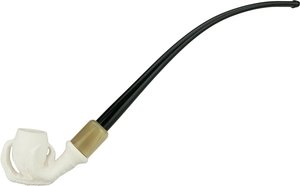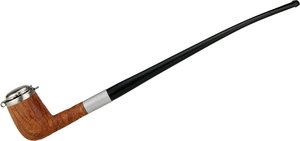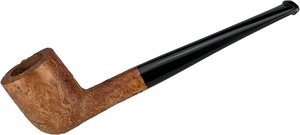Old German Clay Pipes: Bestseller
Old German Clay Pipes: All items
Clay - the "original material" of pipe making
Long before meerschaum or briar was used in pipe making, clay was the predominant material for pipe making. This is because when tobacco came from the "New World", it was an expensive luxury product that only very wealthy aristocrats or merchants could afford. As the demand for tobacco grew, so did the desires of the "working population" to turn to this new stimulant. Clay seemed to be the best material for pipes because it was available almost everywhere and it was very cheap.
The way to Europe
As tobacco began its European triumphal march from England, the first clay pipe makers were also based in England. On the continent, it was clay pipe makers from the Netherlands, mostly around the city of Gouda, who copied these pipes. Of course, the makers needed the raw material, clay, which was of the best quality and came from the Westerwald not far away at all. In the 16th and 17th centuries, the Westerwald was also known as "Kannenbäckerland", because the processing of clay into drinking vessels and crockery had a long tradition here. So it is not surprising that the people who sold clay to the Netherlands soon tried their hand at making clay pipes themselves. By the middle of the 17th century, there were already so many clay pipe bakers in the Westerwald that they were politically forced to organise themselves into a guild. This was not without problems, because through a trade organisation the pipes from the Westerwald were soon known as far away as America, but the traders strongly depressed the prices of the producers. Thus the profession of clay pipe maker became increasingly unattractive and by the 1870s many had already given up their profession.
Revival of the family business
Nevertheless, there were some manufacturers who found their niche and were able to maintain the business. One of them was the family of Markus Fohr, who recently started supplying us with clay pipes of his brand "Old German Clay Pipes". His family had been involved in clay pipe production since 1816, and this was their main source of income until 1978. Markus Fohr has now resumed production almost 20 years ago. With old machines and old tools, some of which are between 100 and 200 years old. However, some production processes have also been mechanised in order to work more economically. The moulds used to press the clay are either made of iron or brass. This allows very precise work and a more filigree design of the pipes. Many of the clay pipe makers still active today, on the other hand, use moulds made of plaster.
Skill and knowledge
The making itself requires some dexterity and knowledge of the firing temperatures (actually over 1000 degrees, over several hours), the composition of the clay and many other things. But much of it is manual work, such as piercing the smoke channel with the help of a long metal spike. The clay itself is still mined in the Westerwald today and is mainly used for technical ceramics. It is known for its fine, white structure. The clay deposits are over 420-360 million years old.
Smoking properties
When writing about the structure of the clay, one should of course also mention something about the smoking properties of clay pipes from the Westerwald. Because these are quite excellent. What makes the smoking properties so excellent are the outstanding suction properties. Liquid, tobacco juices and condensates are very well absorbed by the clay. Reading pipes (churchwardens) made of clay are therefore particularly useful. Unlike briar with a long mouthpiece, they do not splutter. In addition, the clay has a cooling effect due to its structure. So if you like churchwarden pipes, you should definitely try a clay pipe. Of course, clay pipes are not touched on the bowl while smoking, but on the shank.
Special cleaning
Clay pipes, however, are not cleaned in the classical sense with pipe cleaner. This applies at least to pipes that are made of one piece. Rather, they are placed in the middle of a fireplace or campfire and left to "burn". Don't worry, the pipe itself will not be damaged, but all residues will burn off and a completely white pipe will come out of the fire.
Also with ebonite
With his brand "Old German Clay Pipes", Markus Fohr has also taken a somewhat less well-trodden path and produces clay pipes with ebonite mouthpieces or horn tips. These are also available in "conventional length", which can be smoked without any problems, e.g. while writing on the computer or going for a walk. By the way, the tobacco tastes particularly pure and unadulterated, with no off-flavours. We recommend especially Virginias or Oriental blends from clay pipes.
Well known in the USA
By the way, Markus Fohr coined the name "Old German Clay Pipes" through his close cooperation with dealers in the USA, starting from some exhibitions at the Chicago Pipe Show. His pipes are known there - unlike in Germany itself - by almost every pipe smoker. In Germany, he has no specialist dealers who carry his pipes. Apart from smoking accessories wholesalers who order a model from him now and then. So it is not surprising that there were actually some pipe friends who ordered his pipes in the USA. Although they actually lived 20km from Montabaur. Nevertheless, there seem to be many pipe smokers in the USA who appreciate traditional German craftsmanship.
Genuine antique
If you look at the assortment at our "Old German Clay Pipes", you will notice that there are two "antique" pipes among them, which are dark coloured. And on Facebook there were already speculations that it could just be a matter of naming. But these pipes are indeed "antique", because they date from the period between 1880-1890. This can be narrowed down so precisely, because the pipes were wrapped in newspaper, among other things, on which the publication dates can be found. The pipes were found when a previously unknown area of the cellar was discovered. Firewood had been stored in it. After the firewood had been gradually used up, Markus Fohr found nailed-up boxes containing the very pipes mentioned above. So nowadays, as a pipe smoker, you actually still have the chance to buy new pipes that are over a hundred years old.
If you look at the names of the pipes, you will see that they are all named after towns, villages and districts in and around Montabaur. We think there is no better way to honour the traditional origin of these pipes.
Something special
Even though the "shipping handling" and logistics of clay pipes have presented us with challenges, we are very pleased to be the only German retailer to have "Old German Clay Pipes" in our assortment. If you too have a sense of tradition, "antennae" for authentic products and would like to try tobacco the old-fathers' way, try a clay pipe. It is a real treat!























